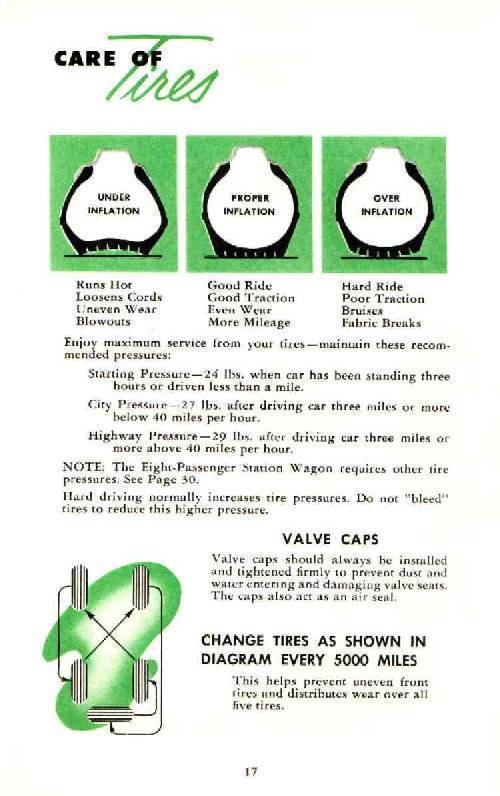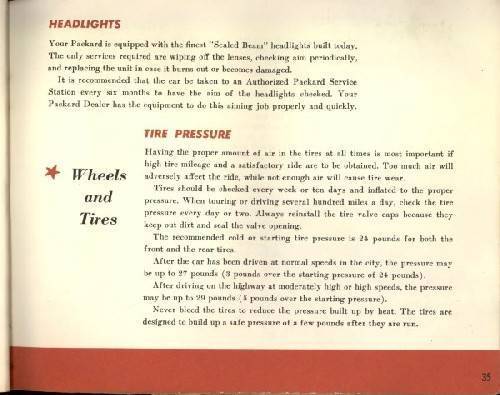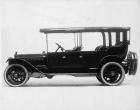|
Re: Tire Pressure
|
||||
|---|---|---|---|---|
|
Home away from home
|
Quote:
Yes, conventional. If my contact patch was small, wouldn't I be getting a wear pattern in the middle of the tire? I'm not. I'm not the only one who runs this high. If all you're doing is nice little rides around town, you're okay to run the low pressure, but when I'm running down the freeway at 75mph for hours at a time, I feel much more comfortable with the 40psi.
Posted on: 2013/3/23 8:10
|
|||
|
West Peterson
1930 Packard Speedster Eight boattail (SOLD) 1940 Packard 1808 w/Factory Air (SOLD) 1947 Chrysler Town and Country sedan 1970 Camaro RS 1936 Cord phaeton packardinfo.com/xoops/html/modules/newbb/viewtopic.php?topic_id=4307&forum=10 aaca.org/ |
||||
|
||||
|
Re: Tire Pressure
|
||||
|---|---|---|---|---|
|
Forum Ambassador

|
West - I am hesitant to comment again on this topic, but after talking to some tire folks I felt it important, if for no other reason than your safety. I was told in no uncertain terms that inflating a tire to significantly above the tire manufacturer's rated maximum pressure can be very dangerous, in part because you've exceeded the design loads for the cord and fabric plies (and perhaps the rim itself) and ultimately cord or ply separation may occur with potentially catastrophic consequences. Of course do as you wish but I'd feel better about this if you discuss this with a technical rep of the tire manufacturer.
Posted on: 2013/3/23 13:27
|
|||
|
||||
|
Re: Tire Pressure
|
||||
|---|---|---|---|---|
|
Home away from home

|
In my 40+ years of owning and operating a wide variety of passenger vehicles from scooters to cars and lite trucks i;ve never found it plausable or necessary to run over 32 psi, radials or bias belted. Usually run 28 to 30 psi.
As for 'blow-outs' of any modern tires made over the last 20 years is unheard of. I've ran some mighty damned cheap priced tyres. Never had a 'blow-out' assuming that means the tire suddenly went flat in just a few seconds at speed. 30-40 years ago a different story. The higher tire pressures can (not necessarily) cause the vehicle to wander or 'hunt' while going down the road especialy at speeds over 40 mph. I've experienced this too many times acros a variety of vehicles both very modern and vintage when pressure gets much over 28 psi radial or biased. Manufaturer recommendations for ANYTHING is exactly that, a recommendation. Recommendations to cover a wide variety of driving environments. I've found that 28 psi is a good starting point. Experiment from 28 psi higher and lower to determine best pressure for tire wear and handling. Optimal can vary from owner to owner driving conditions.
Posted on: 2013/3/23 14:00
|
|||
|
VAPOR LOCK demystified: See paragraph SEVEN of PMCC documentaion as listed in post #11 of the following thread:f
packardinfo.com/xoops/html/modules/newbb/viewtopic.php?topic_id=7245 |
||||
|
||||
|
Re: Tire Pressure
|
||||
|---|---|---|---|---|
|
Not too shy to talk
|
I remember reading an article years ago that coincides with Packard's own recommendation. Generally speaking, If I remember right, correct cold pressure will allow a driven tire to gain approximately 4 psi. If it gains much more than that, the original pressure is low, causing the tire to flex and overheat. If it gains less, the tire is overinflated and not garnering the full capability of the tread or ride comfort.
I simply wanted to confirm that I wasn't reading things wrong or misunderstanding things. It seems so for foreign for a car this big and heavy to have only 20-24 psi in a tire! But, it is what it is. Perhaps it'll ride a lot smoother with the correct pressure. I hope so, anyway. It is not currently a very comfortable ride. We feel every nook and cranny, and the shocks are new.
Posted on: 2013/3/23 22:09
|
|||
|
1952 Packard 200
|
||||
|
||||
|
Re: Tire Pressure
|
||||
|---|---|---|---|---|
|
Home away from home

|
The last blow out I had was on a steel belted radial tire with a 50,000 mile rating. It sounded like a cannon going off. I took my foot off the gas and coasted to a stop.
The left rear of the car was a mess. The year was 2007. Another time I was next to a truck on the Turnpike when BANG! the inside tire next to me blew out. The driver didn't even notice and kept going. I was looking at some 53 Chevy stuff and noticed they specified "Extra Low Pressure Tires" (?) Okay, so what does that mean? Below is a page from the owner's manual. It has some useful notes as to effects of tire pressures. Also below is a page from the 55 Packard Manual. Low and behold - they are the same. Hope this helps.
Posted on: 2013/3/24 10:09
|
|||
|
||||
|
Re: Tire Pressure
|
||||
|---|---|---|---|---|
|
Quite a regular
|
Diamond Back Classics recommends 36-38 lb in their radial 225/75R15. I've had at least 5 sets of these tires on my various 48-53's and have had very good performance.
They say the higher pressures are needed because of the radial sidewall.
Posted on: 2013/3/24 13:12
|
|||
|
1948 Station Sedan
1948 Custom 2 Door Club Sedan 1953 Convertible |
||||
|
||||
|
Re: Tire Pressure
|
||||
|---|---|---|---|---|
|
Not too shy to talk
|
I dropped them down to 25 and will see how it rides and how pressures increase with driving. Will report my findings and make adjustments until the hot pressure is as near to +4 as I can get it.
Posted on: 2013/3/24 13:52
|
|||
|
1952 Packard 200
|
||||
|
||||
|
Re: Tire Pressure
|
||||
|---|---|---|---|---|
|
Home away from home
|
Quote:
I was instructed by DBC to inflate their wide white wall tires that I installed on my 115C to at least 36 lbs to keep the white walls they affixed to the tires from flexing too much and separating from the sidewalls. Normal inflation pressure for the HanKook tubeless radials would not need to be that much without the DBC white wall. Apparently, regular pressure allows too much sidewall flex and will loosen the white walls. I have followed their instructions and the tires and white walls are still together. (o{}o)
Posted on: 2013/3/24 14:01
|
|||
|
We move toward
And make happen What occupies our mind... (W. Scherer) |
||||
|
||||
|
Re: Tire Pressure
|
||||
|---|---|---|---|---|
|
Home away from home

|
1968lew
What does the mfg'er of YOUR tires recommend for pressure??? Is it written on the side of the tire????
Posted on: 2013/3/24 19:36
|
|||
|
VAPOR LOCK demystified: See paragraph SEVEN of PMCC documentaion as listed in post #11 of the following thread:f
packardinfo.com/xoops/html/modules/newbb/viewtopic.php?topic_id=7245 |
||||
|
||||

 (72.04 KB)
(72.04 KB)








